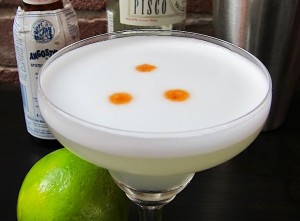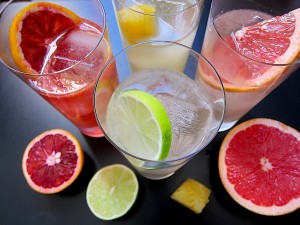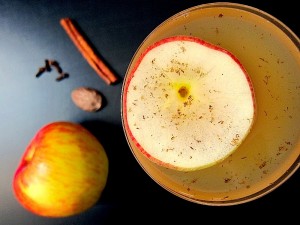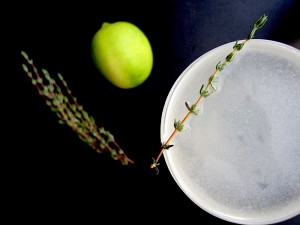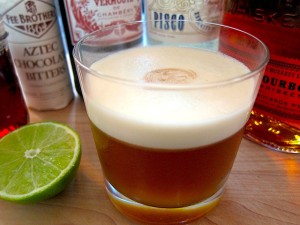Some time ago, I was asked “do you take all the photographs on your blog?” and the answer is Yes! I write all the recipes, cook all the dishes, make all the cocktails, and photograph all the food and drinks. But if you’ve never photographed food, it can be very challenging. Why? Because no matter how good something tastes, you need to make it look like it’s going to taste great in the photo. In other words, of all the senses you can use to enjoy food: sight, taste, smell, sound, and touch, you can only appeal to the sense of sight in a photograph.
Quite simply, the photograph has to make you want to take a bite of the food. Or in the case of the cocktail, take a sip. Photographing cocktails is particularly challenging because many times, the subject is a liquid, that may or may not have much color, which is held in a glass instead of a plate. How do you make it look like something interesting and enjoyable to drink? How do you convey a sense of the ingredients and flavors? Using 5 different photographs for cocktails I’ve made on Pisco Trail, here are 10 tips for photographing cocktails.
- Use natural light
- Arrange the mise en place
- Serve the cocktail in the right glass
- Select a background with appropriate contrast
- Select the right viewing angle
- Show some of the ingredients in the background
- Add color accents
- Focus on one thing
- Take many photos
- Edit the photos and repeat as needed
The 5 photographs we’ll be using as examples are for a Pisco Sour, Chilcano, Pisco Apple Cider Punch, Pisco Thyme, and Mardi Gras Pisco Sour.
The Pisco Sour is typically served in a tumbler or Old-Fashioned glass, but serving it in a coupe highlights the egg white foam that is contrasted nicely with the dark background. Your eyes are drawn to the three drops of Angostura bitters on top, and the bright green lime adds some color pop. The angle of the photographs allows you to see some of the drink beneath the egg white foam, and the close-up makes you want to reach, grab the glass, and take a sip.
A Chilcano is Pisco, lime juice, and ginger ale served with ice. On it’s own it has very little color, so to make this photograph interesting I made four versions of the Chilcano with four different fruits. The natural light shines through the glass on the left, and shimmers where the ice is floating on top of each drink. The drinks are garnished with fruits that are also placed on the dark background next to the glasses for additional color and contrast.
Apple cider on it’s own is a brown muddy color, not particularly appealing as a drink. Showing all the ingredients, such as cloves, cinnamon, nutmeg, and apples, was important to evoke the fall season and the warmth from the spices. From a top view, one can see small pieces of nutmeg zest floating on the surface of the drink, and the large apple round garnish provides a bright contrast to the color of the drink.
Using spices to infuse the flavor of the simple syrup works great, and a cocktail like the Pisco Thyme is very simple: Pisco, lime juice, and simple syrup. That simplicity is reflected in the photograph. A top view shows the partial coupe garnished with a single sprig of thyme in the foreground, balanced on the rim and touching the drink. The dark background is sparse, with a single lime and a few sprigs of thyme that make a v-shape with the garnish.
Though similar to the Pisco Sour, the elements in this photograph are very different. All the spirits are in the background, and the light shines nicely through the bourbon. The dark amber color of the cocktail stands out between the wood surface and the egg white foam. Drops of the chocolate bitter are swirled using a toothpick to create a circular pattern on top of the egg white, and the lime adds some color.
The process to take these photographs was the same. I used natural light and the drinks were all backlit. I set up the mise en place, including any ingredients and props before making the cocktail. After making the cocktail, I present it in the right glass over a background that provides the contrast I am looking for. I try different viewing angles and re-arrange or add ingredients, adding color when needed. While taking photographs, I focus on one aspect of the drink. The rim of the glass, the garnish, the egg white foam, some detail that I want to be sharp, clear, and enticing. It’s not unusual that for any drink, I take over 100 photos, which I review and edit to find the one I like best.
What else can you do to improve your drink or food photography skills. Regardless of the camera, use a tripod to ensure steady shots. Look at other blogs or food magazines for inspiration, and take photography workshops if possible. For the past two years I’ve been attending the International Food Blogger Conference, and have been really inspired by the work of Andrew Scrivani, who always wows the audience with his food photography. It also really helps if you are really inspired by your subject, which in my case is Peruvian cuisine and Pisco cocktails, two things that I will be photographing and writing about for a long long time.
